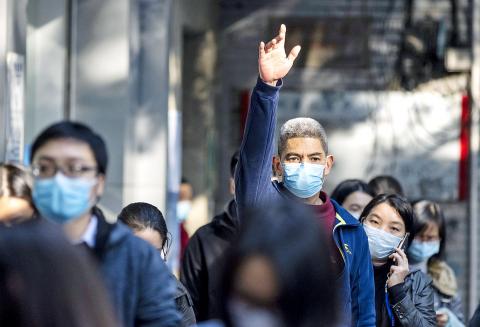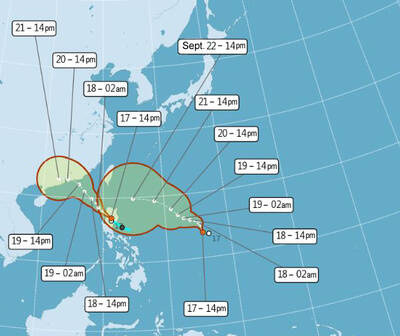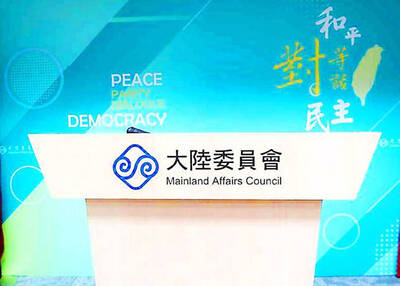China’s official death toll from an outbreak of COVID-19 yesterday spiked dramatically after authorities changed their counting methods, fueling concern that the epidemic is far worse than being reported.
Under criticism at home over the handling of the crisis, the Chinese Communist Party dismissed two top-ranking officials in Hubei Province, the epicenter of the outbreak.
The developments came hours after Chinese President Xi Jinping (習近平) claimed “positive results” from efforts to contain an epidemic that has now officially killed 1,367 people and infected nearly 60,000.

Photo: EPA-EFE
However, the WHO warned that it was too soon to declare victory.
“I think it’s way too early to try to predict the beginning, the middle or the end of this epidemic right now,” WHO Health Emergencies Program executive director Michael Ryan said.
In Hubei and its capital, Wuhan, where tens of millions of people have been trapped as part of an unprecedented quarantine effort, 242 new deaths were reported yesterday.
Another 14,840 people were confirmed to be infected in Hubei alone, with the new cases and deaths by far the biggest one-day increases since the crisis began.
Outside of Hubei, there were 12 more deaths, but the number of new cases fell for a ninth day in a row, with 312 extra patients.
Hubei authorities said that the increases were because they had broadened their definition for infection to include people “clinically diagnosed” via lung imaging.
Up until now, they had been documenting cases using a more sophisticated laboratory test.
Health officials said that they looked into past suspected cases and revised their diagnoses, suggesting that older cases were also included in yesterday’s numbers.
China had been praised by the WHO for its transparent handling of the outbreak, in contrast to the way it concealed the extent of the deadly SARS epidemic in 2002 and 2003.
However, Beijing has been facing skepticism among the global public, with many fearing that there might be similarities to the way it dealt with SARS.
Authorities in Hubei have been accused of concealing the gravity of the outbreak.
Criticism intensified after the death of a doctor who had in December last year tried to raise the alarm about the outbreak, but was silenced by authorities.
Hubei’s new counting methodology might be a legitimate attempt to be more transparent, analysts said, but the immediate effects were to sow more distrust.
“Oddly, this now is a moment of greater transparency,” Williams College political science professor Sam Crane said in Massachusetts.
“It is not clear if the problem up to now, on this issue, was lack of transparency or simply bad medical practice,” Crane said.
Australian National University China researcher Jiang Yun (姜雲) said that the new methodology might be a “practical measure,” because Hubei has a shortage of laboratory testing kits.
“I don’t think the numbers are necessarily manipulated for political purposes, but the numbers themselves may not be so trustworthy,” Yun told reporters.
The leaders of Hubei and Wuhan were fired yesterday, the highest-profile political casualties of the crisis. Hubei’s two top health officials were fired earlier this week.
Shanghai mayor Ying Yong (應勇) took over the top provincial post, while an official from eastern Shandong Province was appointed in Wuhan.
Both are seen as “Xi’s men,” Lowy Institute senior fellow Richard McGregor said.
“I guess if the situation in Hubei is a long way from being under control, the party should be worried about instability, because you are literally going to have tens of millions of people confined indoors at least for another month,” McGregor said.
“I think if you are trying to deal with an emergency, you probably want to choose people you can rely on, who are loyal to you,” he added.

Taiwan is projected to lose a working-age population of about 6.67 million people in two waves of retirement in the coming years, as the nation confronts accelerating demographic decline and a shortage of younger workers to take their place, the Ministry of the Interior said. Taiwan experienced its largest baby boom between 1958 and 1966, when the population grew by 3.78 million, followed by a second surge of 2.89 million between 1976 and 1982, ministry data showed. In 2023, the first of those baby boom generations — those born in the late 1950s and early 1960s — began to enter retirement, triggering

One of two tropical depressions that formed off Taiwan yesterday morning could turn into a moderate typhoon by the weekend, the Central Weather Administration (CWA) said yesterday. Tropical Depression No. 21 formed at 8am about 1,850km off the southeast coast, CWA forecaster Lee Meng-hsuan (李孟軒) said. The weather system is expected to move northwest as it builds momentum, possibly intensifying this weekend into a typhoon, which would be called Mitag, Lee said. The radius of the storm is expected to reach almost 200km, she said. It is forecast to approach the southeast of Taiwan on Monday next week and pass through the Bashi Channel

NO CHANGE: The TRA makes clear that the US does not consider the status of Taiwan to have been determined by WWII-era documents, a former AIT deputy director said The American Institute in Taiwan’s (AIT) comments that World War-II era documents do not determine Taiwan’s political status accurately conveyed the US’ stance, the US Department of State said. An AIT spokesperson on Saturday said that a Chinese official mischaracterized World War II-era documents as stating that Taiwan was ceded to the China. The remarks from the US’ de facto embassy in Taiwan drew criticism from the Ma Ying-jeou Foundation, whose director said the comments put Taiwan in danger. The Chinese-language United Daily News yesterday reported that a US State Department spokesperson confirmed the AIT’s position. They added that the US would continue to

The number of Chinese spouses applying for dependent residency as well as long-term residency in Taiwan has decreased, the Mainland Affairs Council said yesterday, adding that the reduction of Chinese spouses staying or living in Taiwan is only one facet reflecting the general decrease in the number of people willing to get married in Taiwan. The number of Chinese spouses applying for dependent residency last year was 7,123, down by 2,931, or 29.15 percent, from the previous year. The same census showed that the number of Chinese spouses applying for long-term residency and receiving approval last year stood at 2,973, down 1,520,